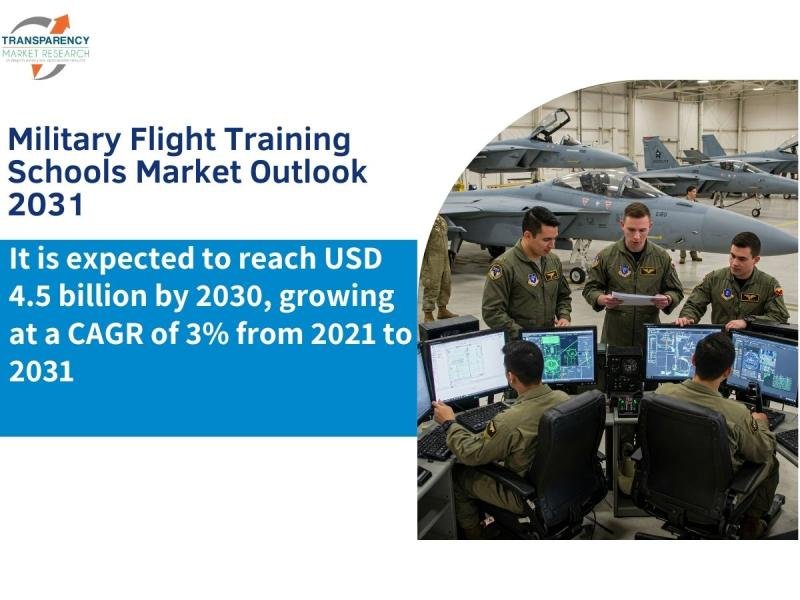The global military flight training schools market is poised to reach new heights, with industry experts forecasting a valuation of USD 4.5 billion by 2030. Driven by an increasing demand for highly trained pilots and innovations in simulation technologies, the market is projected to expand at a steady CAGR of approximately 3% between 2021 and 2031. This press release outlines a comprehensive overview of market dynamics, key players, recent developments, segmentation, regional insights, future outlook, and frequently asked questions, providing a detailed picture of this evolving industry.
Download now to explore primary insights from our Report in this sample – https://www.transparencymarketresearch.com/sample/sample.php?flag=S&rep_id=82183
Market Overview: The military flight training schools market is witnessing robust growth amid rising global security concerns and the modernization of defense infrastructures. Governments worldwide are actively investing in military training institutes to address the shortage of skilled pilots and to maintain a competitive edge in defense readiness. As air forces around the globe face a dearth of experienced aviators, the market is capitalizing on opportunities to expand training capacities through advanced simulation technologies and immersive training devices.
A recent report by Transparency Market Research (TMR) provides a bird’s-eye view of the global military flight training schools market. The study highlights the market’s segmentation into various categories such as aircraft type dividing into fixed wing and rotary wing aircraft and component, which includes both services and hardware. These classifications underscore the complexity and comprehensive nature of training solutions available, catering to the unique needs of modern military aviation.
Market Drivers & Trends
Rising Need for Trained Pilots:
One of the primary market drivers is the escalating demand for trained pilots, especially in countries with expanding defense sectors. For instance, the U.S. Defense Department has reported an increased need for proficient aviators, prompting a surge in enrollment at military flight training schools. This trend is reinforced by the strategic emphasis on preparing air force personnel to navigate advanced aircraft and complex combat scenarios.
Technological Advancements:
Technological innovation plays a crucial role in market expansion. The incorporation of next-generation tools such as artificial intelligence (AI), machine learning (ML), and virtual reality (VR) is revolutionizing training programs. These technologies enable realistic and immersive simulations, significantly reducing training times while enhancing skill acquisition. Moreover, the integration of low-cost simulation programs has democratized access to high-fidelity training, ensuring that pilots can train effectively with reduced operational costs.
Cloud-Based Solutions:
Innovations like Google Cloud are gaining prominence due to their cost-efficiency and scalability. Cloud-based training interfaces support a wide array of plane simulations, ensuring a consistent and secure user experience. This not only improves the training quality but also provides a scalable solution that can adapt to the evolving demands of military training programs.
Key Players and Industry Leaders
The market landscape is characterized by the presence of several high-profile players who are continuously pushing the envelope in terms of innovation and strategic expansion. Notable industry leaders include:
CAE Inc.
Airways Aviation
FlightSafety International Inc.
ELITE Simulation Solutions AG
L3Harris Technologies Inc.
Indra Sistemas SA
Phoenix East Aviation
Lockheed Martin
Thales Group
Upper Limit Aviation Inc.
Raytheon Technologies Corporation
These companies are actively involved in research and development to launch innovative training programs and expand their market footprint. Strategic acquisitions and partnerships are common tactics employed to consolidate market share, reduce competition, and broaden service portfolios. Even amid challenging times such as the COVID-19 outbreak, these key players have maintained operational resilience by implementing safety protocols and adapting their business models to meet emerging needs.
Recent Developments
Recent industry developments underscore a trend toward increased integration of advanced training technologies and strategic acquisitions. Companies are investing in next-generation simulation tools that incorporate AI and VR to provide more realistic and immersive training experiences. This approach not only reduces the time required to train pilots but also minimizes risks associated with live training exercises.
Additionally, there has been a noticeable trend of acquisitions aimed at bolstering capabilities and market reach. Mergers and strategic partnerships are being leveraged to create economies of scale and enhance competitive advantage. These moves are essential to address the growing complexities of military training, ensuring that training institutes are well-equipped to meet both current and future demands.
Market Restraints & Challenges
Despite the promising growth trajectory, the military flight training schools market faces several restraints and challenges:
High Capital Expenditure:
Establishing state-of-the-art training facilities and investing in high-tech simulation equipment requires significant financial outlays. These high upfront costs can be a barrier to entry, particularly for smaller players and emerging markets.
Regulatory Hurdles:
The military and defense sectors are highly regulated, and compliance with stringent safety and operational standards is mandatory. Navigating these regulatory landscapes can pose challenges, potentially slowing down market expansion.
Technological Obsolescence:
With rapid advancements in simulation and training technologies, there is a constant need for updates and upgrades. The risk of technological obsolescence is a persistent concern, requiring continuous investments to remain competitive.
Geopolitical Uncertainties:
Political tensions and defense budget fluctuations in various regions can influence investment decisions and disrupt market stability. These uncertainties necessitate a cautious approach when planning long-term strategies.
Visit our report to discover essential insights and analysis – https://www.transparencymarketresearch.com/military-flight-training-schools-market.html
Market Segmentation
The market is segmented across several parameters, enabling a nuanced understanding of industry dynamics:
By Aircraft Type:
Fixed Wing Aircraft:
This segment primarily includes traditional aircraft used for various military operations, where the emphasis is on precision and high-speed training.
Rotary Wing Aircraft:
This category covers helicopters and other rotorcraft, which are essential for specialized missions such as rescue operations and rapid deployments.
By Component:
Services:
This encompasses pilot training programs, simulator-based training, maintenance, and post-training support services. The focus is on delivering comprehensive training solutions that combine theoretical knowledge with practical simulation.
Hardware:
This segment includes the actual training equipment, such as simulators and flight training devices. Investment in hardware is crucial for creating realistic training environments that mirror real-life scenarios.
Regional Insights
The global military flight training schools market is geographically diverse, with significant opportunities in multiple regions:
North America:
The United States leads the market in North America, driven by its advanced defense infrastructure and continuous investments in training technologies. The U.S. is expected to witness steady growth due to ongoing requirements from both the defense and aerospace sectors.
Asia Pacific:
Rapid economic growth and increasing defense spending in countries such as India, China, and Japan are propelling the market forward. These nations are actively upgrading their training facilities to meet future defense needs.
Europe:
European countries are focusing on modernizing their military training capabilities. The integration of new technologies into training regimes is a priority to maintain operational readiness in a dynamic security environment.
South America and MEA:
While these regions are emerging players in the market, strategic investments in military training infrastructure are expected to drive gradual growth. Government initiatives aimed at improving national security are key drivers in these areas.
Future Outlook
The future outlook for the military flight training schools market is optimistic. As defense budgets increase and governments recognize the strategic importance of advanced training, investments in simulation technologies and state-of-the-art training facilities will continue to rise. The adoption of AI, ML, and VR is set to revolutionize pilot training, making it more efficient and cost-effective. Moreover, cloud-based training solutions such as Google Cloud are likely to play an instrumental role in delivering scalable and secure training experiences.
Market participants are expected to focus on R&D and strategic acquisitions to stay ahead of technological trends and evolving security challenges. The continuous evolution of training methodologies will not only enhance pilot proficiency but also contribute to overall defense preparedness in an increasingly complex global security landscape.
Why Buy This Report?
The comprehensive report by Transparency Market Research offers invaluable insights for stakeholders and decision-makers in the military flight training schools market. By purchasing this report, readers will gain access to:
In-depth Market Analysis:
A thorough examination of market dynamics, including growth drivers, trends, restraints, and challenges.
Strategic Segmentation:
Detailed segmentation by aircraft type and component, providing a clear understanding of different market facets.
Regional Breakdown:
A granular analysis of market trends and opportunities across key geographical regions, aiding strategic planning.
Competitive Landscape:
Insight into the strategies and performance of leading industry players, along with emerging trends in acquisitions and innovations.
Future Projections:
Forecasts and future outlooks that help in anticipating market developments and making informed investment decisions.
This report is an essential resource for investors, policymakers, and industry professionals seeking to navigate the evolving landscape of military flight training and capitalize on emerging opportunities.
Frequently Asked Questions
What is the study period of this market?
The Military Flight Training Schools Market is studied from 2020 to 2030, providing a decade-long perspective on industry trends and dynamics.
What is the projected market size of the Military Flight Training Schools Market?
The global military flight training schools market is expected to achieve a valuation of US$ 4.5 billion by 2030, reflecting significant growth potential over the forecast period.
What is the projected market growth rate of the Military Flight Training Schools Market?
The market is estimated to expand at a CAGR of approximately 3% during the period from 2021 to 2031, driven by rising demand and technological advancements.
Which region holds the maximum share of the Military Flight Training Schools Market?
North America, particularly the United States, holds a dominant share in the market due to its advanced defense capabilities and significant investments in training infrastructure.
What are the top players operating in the Military Flight Training Schools Market?
Leading companies in this sector include CAE Inc., Airways Aviation, FlightSafety International Inc., ELITE Simulation Solutions AG, L3Harris Technologies Inc., Indra Sistemas SA, Lockheed Martin, Phoenix East Aviation, Raytheon Technologies Corporation, Thales Group, and Upper Limit Aviation Inc.
Buy this Premium Research Report for exclusive, in-depth insights – https://www.transparencymarketresearch.com/checkout.php?rep_id=82183<ype=S
Explore Latest Research Reports by Transparency Market Research:
Government Biometrics Market: https://www.transparencymarketresearch.com/government-biometrics-market.html
Inertial Measurement Unit Market: https://www.transparencymarketresearch.com/inertial-measurement-unit-market.html
About Transparency Market Research
Transparency Market Research, a global market research company registered at Wilmington, Delaware, United States, provides custom research and consulting services. Our exclusive blend of quantitative forecasting and trends analysis provides forward-looking insights for thousands of decision makers. Our experienced team of Analysts, Researchers, and Consultants use proprietary data sources and various tools & techniques to gather and analyses information.
Our data repository is continuously updated and revised by a team of research experts, so that it always reflects the latest trends and information. With a broad research and analysis capability, Transparency Market Research employs rigorous primary and secondary research techniques in developing distinctive data sets and research material for business reports.
Contact:
Transparency Market Research Inc.
CORPORATE HEADQUARTER DOWNTOWN,
1000 N. West Street,
Suite 1200, Wilmington, Delaware 19801 USA
Tel: +1-518-618-1030
USA – Canada Toll Free: 866-552-3453
Website: https://www.transparencymarketresearch.com
Email: sales@transparencymarketresearch.com
This release was published on openPR.















